We were booked "Off Shed" at 10:15, so it was not a very early start for me. As I walked through the site to reach the locomotive shed, there were many uniformed re-enactors around. The programme listed ten re-enactor organisations as attending, representing German, Russian, American and British combatants, together with civilian groups.

The wooded area was temporary home to numerous tents.
Although it had been a mild night, I didn't envy the re-enactors who had camped overnight.
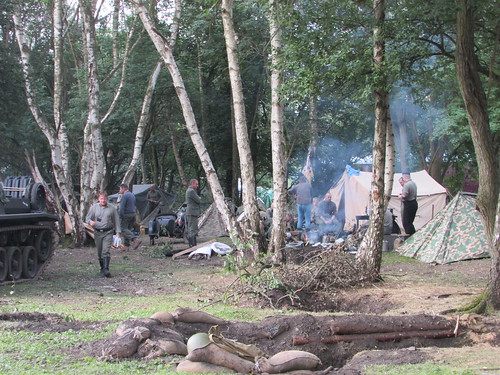
Following a night under canvas, re-enactors enjoy breakfast around the campfire.
There were armoured vehicles, including a tank, various lorries, motor cycle combinations and Jeeps spread around the site.
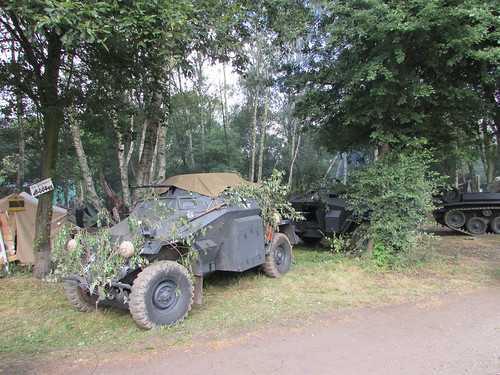
There was plenty of military hardware, both restored and replica, on site.
I spent the next hour with Dave and Colin preparing the 'Austerity' tank locomotive 'Lord Phil' for traffic. We were to operate with the locomotive turned to face north and attached to the north end of the stock. This change had been made the previous weekend, when I had also been driving, so I was already aware of the operating arrangements. We were operating with a 7-coach train, top and tailing with the 'Class 31' (which had been left coupled to the stock overnight) at the south end. During the previous year's 1940s weekend, when I was also driving, 'Lord Phil' had similarly been coupled at the north end of the train but hauling 'bunker first', eliciting critical remarks from certain photographers who, quite reasonably, favoured a 'chimney leading' composition.
Having tested both injectors and the brakes, we shunted from the locomotive yard to Rowsley Station and were 'hooked on' to the train in good time. There were lots of people arriving, many of them in civilian or military dress for the 1940s period. The first departure at 11:00 was completely full. Of course, the 'Class 31' hauled the train to Matlock Town, so we suffered the indignity of being 'tail end charlie' to an anachronistic diesel electric locomotive. The 'Class 31' were originally known as the 'Brush Type 2', introduced as part of the British Railways 'Modernisation Programme'. They were built from 1957 to 1962. Our steam locomotive was only just 'in period', being built by Hunslet in 1944. However, the locomotive committed the first faux pas of the day by being slightly younger than the driver.
We arrived at Matlock Town and Dave walked along the platform to meet the 'Second Man' off the 'Class 31' to collect the Train Staff which we needed to carry as authority for our journey back to Darley Dale. I climbed onto the front framing of the locomotive to 'set the lamp' which had served as a tail lamp on the way to Matlock Town and now needed to be placed on the 'chimney' lamp bracket to indicate 'Ordinary Passenger Train' on the way back to Rowsley. Meanwhile, Colin made ready for our return journey, topping up the boiler with the driver's side injector.
Then, I'm afraid, the locomotive committed the second faux pas of the day when the driver's side injector failed. A shout from Colin hastened me back to the footplate and the unusual sight of a column of hot water rising through an aperture in the footplate in the driver's corner. Colin was using a spanner to close the injector shut-off valve (correctly called the 'Delivery Stop Valve') which stopped the unexpected discharge. The injectors are mounted under the cab floor and it appeared that the non-return valve in the boiler feed outlet from the right hand injector had failed to close correctly, allowing the pressure in the boiler to force hot water back into the injector, which then discharged itself through the path of least resistance (usually the injector overflow pipe). Once I'd satisfied myself that the stop valve was properly isolating the faulty injector and that the left hand injector was working normally, I decided to work the train back to Rowsley where assistance could be more readily provided since we'd seven coaches full of passengers and I was reluctant to 'strand' them at the wrong end of the line.
Problems with injectors are quite common, which is why most locomotives have duplicated injectors. The non-return valve in the boiler feed is often called the 'clack' and there's a short piece on clack valves here. There's also a report about injector problems with another 'Austerity' in the post A Saturday at Peak Rail. The Davies and Metcalfe 'Monitor' Live Steam Injector, used on 'Austerity' tank locomotives, has a good reputation and it's well-worth studying the manufacturer's publication here.
We had no difficulty working the train back to Rowsley where the engineering staff were able to have a look at the problem but, as we expected, concluded that no simple repair was possible. The fireman's side injector was still behaving itself so I was happy to work the second round trip to Matlock Town whilst arrangements were made for the rest of the day. We arrived back at Rowsley after the second round trip and took water. We were informed that the remaining three round trips would be undertaken by the 'Class 31' working alone to Matlock Riverside only and running round its train at Matlock Riverside and Rowsley. Accordingly, we uncoupled and moved the locomotive across to the shed. We had a little shunt to do as we had been instructed to draw the 'Class 14' out of number 2 shed road and stable it outside on number 3 shed road. Once I'd 'cleaned' the fire, this allowed us to position 'Lord Phil' inside the shed on number 2 road (where the 'Class 14' had been), ready for attention to the misbehaving driver's side injector.
I was disappointed at not being able to complete our 'diagram' but the consolation was that I'd be able to lock-up the shed in time to watch the 'battle re-enactment'. Footplate crew normally miss this event, which takes place whilst the service train runs down to Matlock and back.

Peak Rail 40s Weekend 2016: A view of the 'Class 31' arriving at Rowsley, following 'Lord Phil' being taken out of service.
Of course, there's another 'Austerity' on site - 'Royal Pioneer', currently undergoing a 10-year 'Heavy Repair'. This was displayed on the turntable (minus boiler). Although the 'Austerity' is large as six-coupled shunting engines go, the picture below emphasises the short wheelbase, which allows the class to operate on sharp curves.
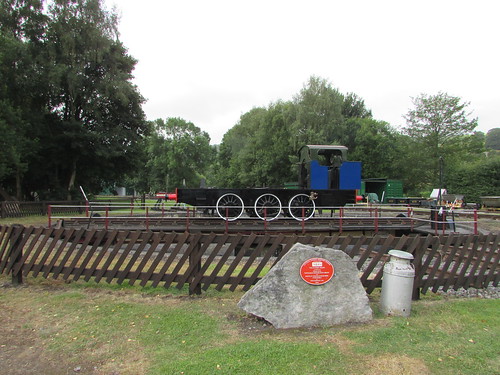
'Royal Pioneer', under repair, displayed on the turntable at Rowsley. The short wheelbase allows operation on sharp curves.
Once the 'Class 31' had departed, the delayed battle re-enactment, complete with pyrotechnics, took place in the wooded area facing Rowsley Station platform. As usual, the long platform formed a safe viewing area for the spectators. Paul Harper, who was providing E.N.S.A. entertainment in the large marquee during the day, provided a very useful commentary clarifying the action.
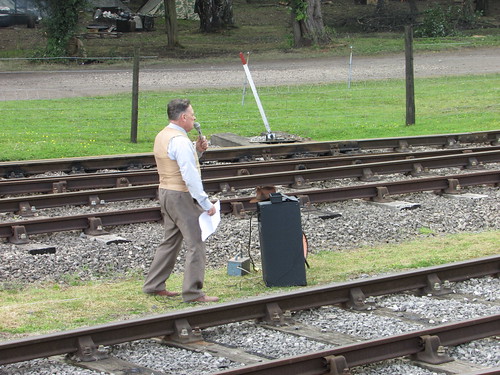
Paul Harper provided a commentary on the battle re-enactment.
The outline description in the programme read:-
A small Russian reconnaissance patrol is returning from a mission and is being pursued by the enemy. The Russians take cover in the woods to form an ambush. The Germans stop a short distance from the woods and open fire with cannon and machine guns. The enemy call up more armoured vehicles including a halftrack, tank, armoured car and prepare for the inevitable battle.

Re-enactors 'take a bow' at the end of the battle.
In the large refreshment marquee, Sue and Steve Mace were dancing to the typical '40s music of Ashby Little Big Band
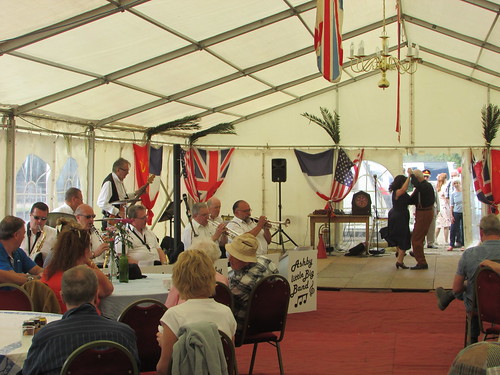
The large marquee with Sue and Steve Mace dancing to the music of Ashby Little Big Band.
There was lots more to see at what has become a major event for Peak Rail. A display of period civilian vehicles which included a 'Fordson' tractor was watched over by two '40s police.

Peak Rail 40s Weekend 2016: '40s police at the display of period civilian vehicles.
The Peak Park area had various other military encampments. A portable field telephone cord exchange particularly caught my attention.
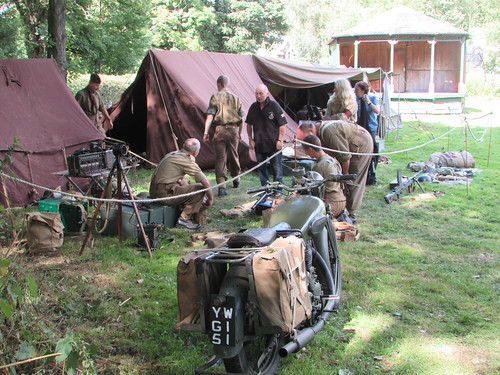
Peak Rail 40s Weekend 2016: Military encampments in the Peak Park area.
There were also a number of trade stalls selling memorabilia, clothing and militaria from the '40s.

Peak Rail 40s Weekend 2016: Trade stalls and part of the military encampment area.
Well, the day didn't quite go to plan but it was interesting and a reminder of the hardship and loss suffered by millions during the '40s which I always find salutary.
Related posts/pictures
I've participated in the 1940s Weekend at Peak Rail on a number of previous occasions.
Peak Rail 1940s Weekend, 2015 2014 event (pictures only).
2013 event (article with link to pictures).
2012 event (article with link to pictures).
2009 event (article with link to pictures).
2008 event (article with link to pictures).
2007 event (pictures only).
2006 event (pictures only).
My pictures of the 2016 event
Peak Rail 1940s Weekend, 2016.
